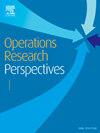Cloud seeding optimization under uncertainty: A Markov chain approach in a two-stage fuzzy-stochastic framework
IF 3.7
4区 管理学
Q2 OPERATIONS RESEARCH & MANAGEMENT SCIENCE
引用次数: 0
Abstract
The occurrence of sequential droughts and various forms of water shortages globally underscores the urgent need for sustainable water management solutions. In this context, cloud seeding has gained attention for its potential to enhance precipitation, yet its effectiveness is often uncertain due to complex cloud microphysics and atmospheric conditions. Acknowledging the inherent uncertainty in this endeavor, in this study, we employ a two-stage stochastic framework, integrating strategic decisions (facility location and network design) and operational realizations (seeding planning according to storm trajectories). Additionally, our model also considers fuzzy nature of seeding parameters. Above all, we develop a Markov chain procedure to mathematically model the prediction of expected increase in precipitation across cloud seeding decision-making processes. The integration of these stochastic methods into existing deterministic models from the literature results in a multi-objective Mixed-Integer Linear Programming (MILP) model designed to maximize rain probability and coverage while minimizing system-wide costs. To enhance the scalability and efficiency of the model, valid inequalities are developed to reduce the domain of binary variables. Additionally, a Lagrangian relaxation technique is proposed, yielding exact optimal solutions within reasonable timeframes and facilitating the handling of continuous space instances. Finally, a real-world case study in Iran demonstrates significant enhancements in precipitation predictions, with the Markov chain procedure showing an average 55 % increase in expected rain probability based on optimized seeding decisions. Scenario-based stochastic programming yields an 11.7 % value of stochastic solution and 16.5 % expected value of perfect information for cloud seeding initiatives.
不确定性下的播云优化:两阶段模糊随机框架下的马尔可夫链方法
全球接连发生的干旱和各种形式的水资源短缺突出表明迫切需要可持续的水管理解决办法。在这种情况下,人工降雨因其增强降水的潜力而受到关注,但由于复杂的云微物理和大气条件,其有效性往往不确定。考虑到这一努力中固有的不确定性,在本研究中,我们采用了一个两阶段的随机框架,整合了战略决策(设施选址和网络设计)和业务实现(根据风暴轨迹进行播种规划)。此外,我们的模型还考虑了种子参数的模糊性。最重要的是,我们开发了一个马尔可夫链过程来数学模拟在云播决策过程中预期降水增加的预测。将这些随机方法整合到现有的确定性模型中,得到一个多目标混合整数线性规划(MILP)模型,该模型旨在最大化降雨概率和覆盖范围,同时最小化系统范围的成本。为了提高模型的可扩展性和效率,提出了有效的不等式来减少二元变量的定义域。此外,提出了一种拉格朗日松弛技术,在合理的时间范围内得到精确的最优解,并便于处理连续空间实例。最后,伊朗的一个实际案例研究表明,降水预测的显著增强,马尔可夫链程序显示,基于优化的播种决策,预期降雨概率平均增加55%。基于场景的随机规划得到的播云方案的随机解值为11.7%,完美信息期望值为16.5%。
本文章由计算机程序翻译,如有差异,请以英文原文为准。
求助全文
约1分钟内获得全文
求助全文
来源期刊

Operations Research Perspectives
Mathematics-Statistics and Probability
CiteScore
6.40
自引率
0.00%
发文量
36
审稿时长
27 days
 求助内容:
求助内容: 应助结果提醒方式:
应助结果提醒方式:


